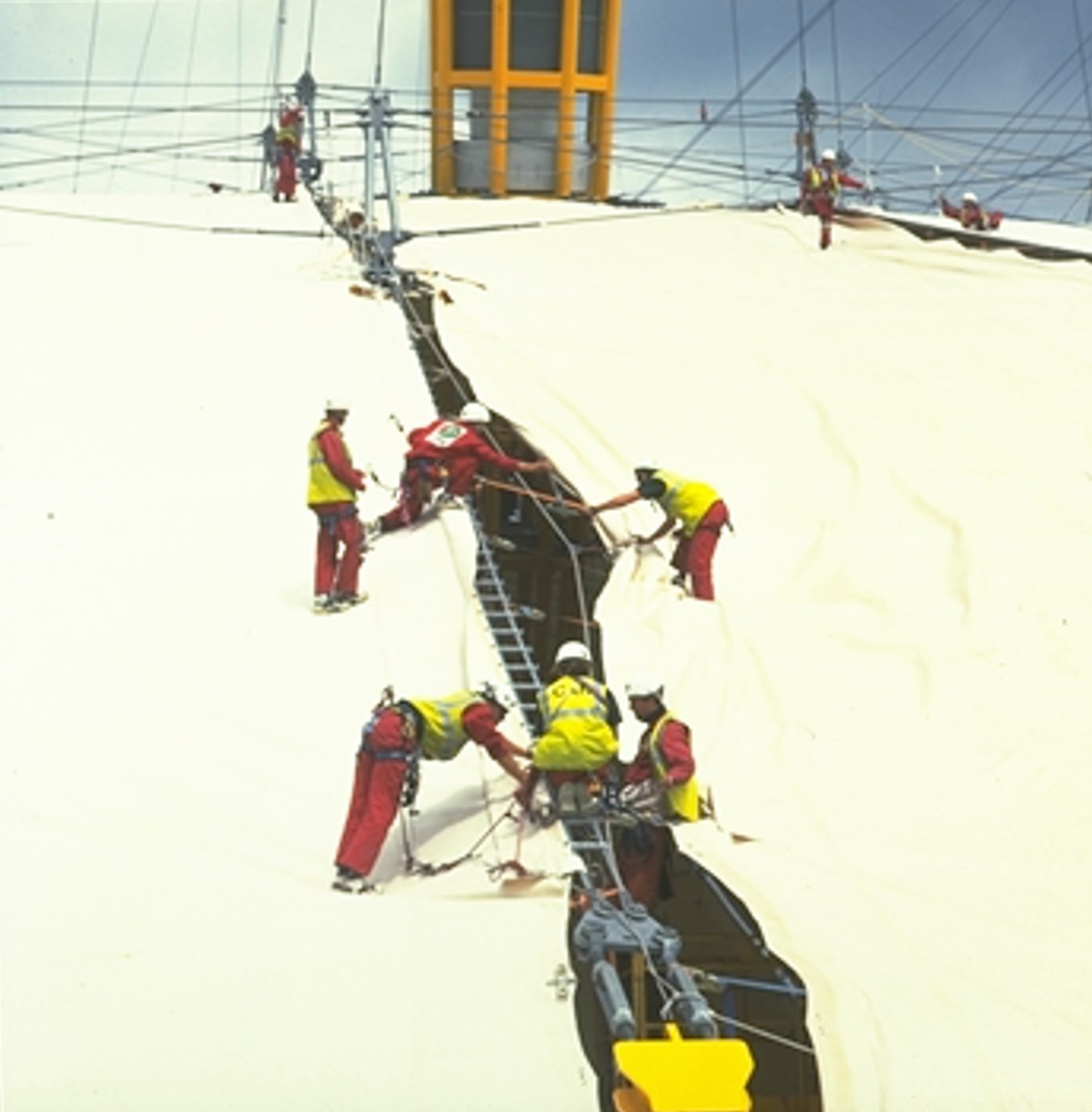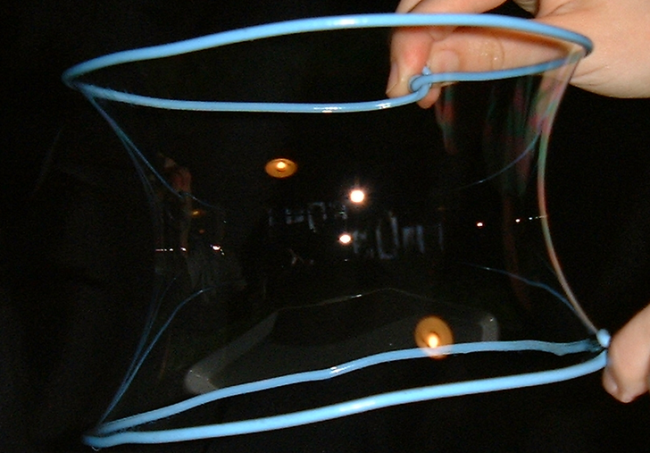Structural membrane

|
| The Millennium Dome, London is a cable net structure that features a double-layer PTFE-coated glass fabric membrane. |
A (non-biological) membrane is a very thin, sheet-like material, such as cling film, soap film or a piece of cloth. Membranes may be used as structural components of tensile structures. A tensile structure is a structure that is stabilised by tension rather than compression. For example, a piece of fabric pulled in opposite directions in a tent or inflatable structure.
Materials that are commonly used as structural membranes include cotton canvas, PVC coated polyester and PTFE coated glass. They may also be formed by foils, films, reinforced films, inflated cushions and so on. For more information see: Architectural fabrics.
These membranes are typically part of a system which makes use of cables, pylons, anchors and so on which force the membrane to adopt a tensioned anticlastic or synclastic form.
From a structural perspective, membranes are extremely thin relative to their span; this means that there are certain stresses – such as those resulting from bending – which they cannot appreciably develop. Membranes are therefore mainly affected by tensile stresses, and for this reason can be employed usefully as materials of construction in which they bear mainly tension forces. Analogously, just like the shortest line between two points is a straight line, so the smoothest possible surface connecting points on a boundary is a membrane - as is seen for example in the form of soap films, which adopt minimum surface shapes.

|

|
Membranes can support loads in a similar way that cables do: they adopt a curved catenary shape (generally doubly curved in the case of membranes), and in so doing, distribute uniformly the two-dimensional forces across their cross-sectional areas.
Essentially, membrane action involves tensile and shear stresses: these are planar i.e they act along the membrane, never perpendicular to it.
Membranes remain more stable under load when they are pre-tensioned. An example is an umbrella, in which the material is placed under a curving pre-tension by the outward force of the struts emanating from the central pole. This means they distort less when subsequently blown by the wind.
At 320m in diameter, the Millennium Dome is the largest dome in the world. The pre-stressing applied to its double-layer PTFE-coated glass fabric material is applied by cables (from ground anchors and those supported by pylons) which force the membrane into a dome shape. However, although cable net structures such as the Millennium Dome can adopt an overall domed shape, it should be noted that individual sections are generally flat or anticlastic in form (rather than the synclastic form of compression domes).
One architect who played a leading research and developmental role in pre-stressed fabric structures was the German architect, Frei Otto. His projects included the bandstand for the 1955 Federal Garden Exhibition in Kassel; the twin saddle structures at the entrance to the 1957 Cologne garden exhibition; the 8,000m² German pavilion for the 1967 Montreal Expo in Canada, and the plexi glass-clad cable net of the 1972 Munich Olympic Stadium.
[edit] Related articles on Designing Buildings Wiki
- Anticlastic.
- Architectural fabrics.
- Buckminster Fuller.
- Deflection.
- ETFE.
- Fabric structures.
- Frei Otto.
- Geodesic dome.
- Hyperbolic paraboloid.
- Kinetic facade.
- Khan Shatyr Entertainment Centre.
- London 2012 Olympic Stadium.
- Long span roof.
- Megastructure.
- Millennium Dome.
- Principles of enclosure.
- Structural steelwork.
- Structures at the end of their design life.
- Tensile structures.
- The history of fabric structures.
- The structural behaviour of architectural fabric structures.
- The thermal behaviour of spaces enclosed by fabric membranes.
- Types of dome.
Featured articles and news
The UK's Modern Industrial Strategy: A 10 year plan
Previous consultation criticism, current key elements and general support with some persisting reservations.
Building Safety Regulator reforms
New roles, new staff and a new fast track service pave the way for a single construction regulator.
Architectural Technologist CPDs and Communications
CIAT CPD… and how you can do it!
Cooling centres and cool spaces
Managing extreme heat in cities by directing the public to places for heat stress relief and water sources.
Winter gardens: A brief history and warm variations
Extending the season with glass in different forms and terms.
Restoring Great Yarmouth's Winter Gardens
Transforming one of the least sustainable constructions imaginable.
Construction Skills Mission Board launch sector drive
Newly formed government and industry collaboration set strategy for recruiting an additional 100,000 construction workers a year.
New Architects Code comes into effect in September 2025
ARB Architects Code of Conduct and Practice available with ongoing consultation regarding guidance.
Welsh Skills Body (Medr) launches ambitious plan
The new skills body brings together funding and regulation of tertiary education and research for the devolved nation.
Paul Gandy FCIOB announced as next CIOB President
Former Tilbury Douglas CEO takes helm.
UK Infrastructure: A 10 Year Strategy. In brief with reactions
With the National Infrastructure and Service Transformation Authority (NISTA).
Ebenezer Howard: inventor of the garden city. Book review.
The Grenfell Tower fire, eight years on
A time to pause and reflect as Dubai tower block fire reported just before anniversary.
Airtightness Topic Guide BSRIA TG 27/2025
Explaining the basics of airtightness, what it is, why it's important, when it's required and how it's carried out.
Construction contract awards hit lowest point of 2025
Plummeting for second consecutive month, intensifying concerns for housing and infrastructure goals.
Understanding Mental Health in the Built Environment 2025
Examining the state of mental health in construction, shedding light on levels of stress, anxiety and depression.
The benefits of engaging with insulation manufacturers
When considering ground floor constructions.
Lighting Industry endorses Blueprint for Electrification
The Lighting Industry Association fully supports the ECA Blueprint as a timely, urgent call to action.























